Visiting the summit of Mauna Kea is high on many visitor’s to-do list when coming to the island. The summit region is spectacularly beautiful, even after six years of visiting several times a week I still find it so. My habit is to drive, or to ride shotgun in order to enjoy the view. I keep a camera at hand, ready for the inevitable situations where beautiful is transformed to spectacular with a well placed cloud or shaft of sunlight.
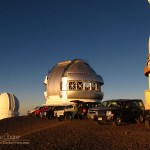
Assorted Notes…
It takes a minimum of two hours to drive to the summit from Waimea or Hilo, an hour longer from much of Kona. Add some more time to the schedule to account for the places you will want to stop along the way. The two hours includes a long stop at the MKVIS to hit the bathroom and allow your body to adjust to the altitude.
There are two opportunities for telescope visits… Keck maintains a lobby and viewing gallery where you can see the Keck 1 telescope. This is open business hours (10am-3pm M-F) and is opened for the MKVIS staff led tour on weekends. Subaru has inside tours that are available with advanced arrangement. Keck and Subaru are the only summit facilities that offer any kind of public accommodation. In all cases you need to supply your own transportation to the summit.
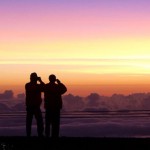
The summit is generally open to exploration. You may wander where you will and visit the summit region freely. There are trails to a few points off the road, including the true summit. Keep in mind that it will be a lot harder going back up if you go down.
Sunrise and sunset create absolutely fantastic sights, planning your visit at dawn or into the evening is a good plan. Sunset works well as you can stop on the way down to enjoy the stars at the MKVIS, complete with an array of telescopes set up for public viewing. You can find the times for sunrise and sunset, along with a weather forecast just for the summit at the Mauna Kea Weather Center website. There is also an array of webcams atop the summit that allows a quick look at conditions before you head up.
When on the summit please remember that the area is sacred to the native Hawaiian culture. You will find offerings to the various Hawaiian deities at several sites, objects wrapped in ti leaves, braided leis, bits of coral or tropical fruit… Leave them alone! It is similar to visiting a church or temple, a little respect for local beliefs is proper.
Safety
In all likelihood any visit to the summit will go without any trouble. But as with life in general, stuff can happen. Here it is just a bit more likely than anywhere else due to the unique nature of the site. A little information can keep a small issue from becoming a major issue. Do spend a few moments to cover that information.
My first advice? Download the safety brochure. This is the official brochure you will find at the MK Visitor Information Center and at the various observatories. Read it! It is quick and easy to read, with the important bits well covered. I am not going to repeat everything in the brochure, I am just going to add my own commentary on a few subjects that might be useful…
Altitude
The official information on visiting Mauna Kea is a bit scary when you read it. It describes all manner of horrible things that can happen to you while visiting the summit…
The summit elevation is 13,796 feet (4,205m). The oxygen level is greatly reduced and you can experience shortness of breath and/or imparied judgement. Reduced atmospheric pressure at high altitudes may cause altitude sickness or result in the development of other life threatening conditions such as pulmonary edema (fluid in the lungs) and cerebral edema (fluid on the brain). – Mauna Kea VIS Information
That is the official line, my personal experience? It is all true! After six years on the mountain I have seen it happen. (Except perhaps the pulmonary or cerebral edema part) I have seen folks faint, get dizzy, get violently nauseous, even experience more serious symptoms, up to unconsciousness and medical evacuation.
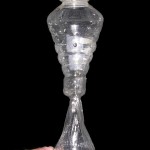
You just do not know who will be affected by the altitude. I have seen guys who looked ready to run a marathon have trouble within twenty minutes. I have seen others, who could charitably be described as fat slobs, walk around for hours without trouble. My personal rule of thumb is that in any group of twenty or thirty people, someone will have difficulty with the altitude.
A couple examples… I was talking to a high school student one time when she suddenly stopped talking, her eyes rolled back in her head and she simply slid down the wall behind her. I was looking right at her when it happened, an interesting thing to watch. You just don’t believe this could happen, or even happen to you, until it does. A few minutes later she was fine, she regained consciousness and was pretty much back to normal. We had her on the first vehicle off the summit, ahead of the rest of her tour, and accompanied by several other students who were also having issues.
On another occasion I sat down in our break room to have my lunch, a break room busy with a tour from a local school. Sitting at the same table was a student and her chaperone. Her head was down on the table, I looked at the chaperone, “She is just tired an put her head down” was the answer. I shook her shoulder attempting to wake the student, she was passed out! We had her on oxygen a few moments later and on a vehicle a few minutes after that, to be met by an ambulance halfway down the mountain.
There is a theme to these experiences… Younger folks, teens and early twenties seem to have more trouble than mature adults. Not sure if that data can be found in medical literature, but that is my experience, an observation echoed by a number of other folks with long experience on the mountain.
There is only one real treatment for altitude sickness… Get off the summit! In all of the cases I have seen the person was just fine after retuning to lower elevation. A number of cases involved checkout at an emergency room, but that was all, checkout and release.
Should you let this scare you? No. Unless you know your cardio-pulmonary system is compromised by some medical condition, there should be no obvious reason not to visit the summit. Just remember to take the possibility of altitude sickness seriously and watch for symptoms in yourself and those with you.
If you really want to see what the elevation change can do… Remember to close up an empty water bottle at the summit and see what it looks like when you get down.
Vehicles
The road to the summit is rough and steep. There are few guardrails along sections where the roll to the bottom would be a very long way down. If you grew up driving back country roads and gravel you will have no problem here. For those used to driving city streets you will need to take it slow and easy. The summit road speed limit is 25mph, with many folks unused to the road opting to go much slower than that. The observatory vehicles, driven by folks who do this every day will want to pass you if you are going slow, do us a favor and pull over. Thanks!
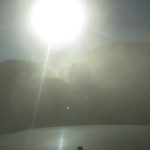
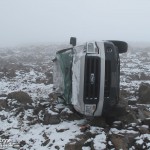
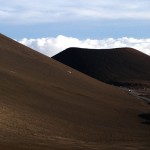
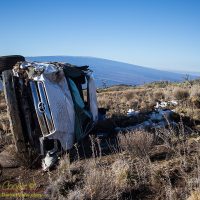
If you have ever experienced brake fade you know what scary is! Imaging needing the brakes, pressing the pedal, and nothing happens! I did this once, when I was young and inexperienced, lived to tell the tale, and will not do it again! I do use the brakes on the way down, on the steeper slopes and in curves, but use low gear as the primary method of speed control.
Enjoy Your Visit!
By all means, visit the summit of Mauna Kea, it is a beautiful and special place. Do take a little more care here, the summit can be dangerous, particularly to people who do not take those dangers seriously.

